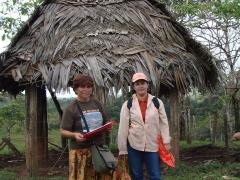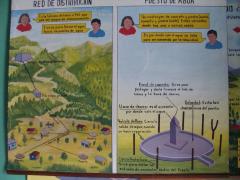rfay's blog
APLV: Promoting Health and Sanitation
The organization we visited in Rio Blanco, Nicaragua, Agua Para La Vida, believes in an integrated approach to making a difference in a community. So they don't just drop a potable water system and disappear. They try to set up a program that will be self-sustaining and which can make a long-term difference in the health and welfare of the community. For that reason they always provide an outhouse (actually constructed by the family), and have a health team in charge of evaluating the community's needs, training them in appropriate health practices, and monitoring the water quality of the installed system.
Lilian Bando and Gregoria Espinoza have been working for APLV in their role as health promoters for a dozen years, and they still find that their educational role is the most important thing they do.
When they arrive at a new project, it's quite common to find that there are few or no outhouses (of course there are no sewage or water systems, so outhouses, where they exist, are the workhouses of sanitation in rural Central America). And it's also common to find that the entire community is ignorant of basic concepts like handwashing after going to the bathroom, proper management of drinking water, appropriate disposal of trash, and the like. read more here... lee mas aquí... »
APLV: Reforestation and Environmental Work
The second day we were in Rio Blanco at APLV in Rio Blanco Fadir Rojas, APLV's reforestation engineer, took us for a hike up into the beautiful Cerro Musún wilderness reserve right next to the town, where he used to work as an engineer and ranger. We spent the afternoon climbing up into virgin forest to a beautiful waterfall called Cascada Las Golondrinas (the swallows). As we walked along we chatted about his responsibilities with APLV and the growing importance of reforestation within the goals of the organization.
Fadir is from a purely campesino family in the dry, heavily populated western part of the country. His parents barely went to school - perhaps to the first grade - and can't really read, but they pushed education in their family and Fadir is one of four university graduates in his family. He succeeded in getting full scholarships for his university education at the national university and is now, at 27, one of the elite young leaders of Nicaragua.
When Fadir came to APLV he found that their vision of reforestation was too limited: They understood the idea of using forest management to project the water source from contamination, but the integrated management plan did not include enough emphasis on protecting the watershed itself from deforestation. read more here... lee mas aquí... »
Agua Para La Vida: The Community does all the work!
(We'll have pictures and updates to this article in a couple of days.)
When a community gets interested in a water project and approaches APLV, it has to go through a number of steps before the project can become a reality. One of the first steps is to commit to doing all of the unskilled labor and provide hospitality to the APLV technical staff when they are onsite. Although APLV provides the materials and engineering, the community does an extremely difficult job - each family normally commits to between 42 and 62 days of labor for the project. You can imagine what that means to people who have very little to take that much time out of the course of a project (6 months to a year). The families build their own outhouses, and the men do all the trenching and the concrete work. This is a pile of work, as the piping often runs for 6-9 miles (10-15 kilometers).
If you're interested in more information on Agua Para La Vida or would like to contribute, they have an excellent website at APLV.org where you can get the whole scoop or make a contribution. It takes just $30,000 to $60,000 to fund a complete village project that may benefit 100-200 families, complete with potable water, outhouses, community health training, and reforestation planning. It is even possible to fund an entire project (and then visit for the inauguration of the project), but of course most of us give in smaller chunks. read more here... lee mas aquí... »
APLV: Home-Grown Leadership
Esteban Cantillano is one of the amazing success stories of APLV. In 1993 he was a campesino living in a little, remote village where APLV was developing a potable water project. He was elected the coordinator by the community, so was responsible for all the interface with the community. But he asked a pile of questions of the brigade from UC Berkeley that was putting in the system! He wanted to know about everything. He was eventually invited to join the first class of the "Potable Water Technical School", a technical high school program, but protested that he had only finished the 6th grade. They said "well, try it out - we'll take you on probation." That was in 1993. Needless to say, he finished with honors (and later went back and did his 7th-10th grade education!) and became one of the pillars of APLV. He has served in the technical/design role he was trained for, as the social coordinator (who does the contact with the village, local government, landowners, and the like), and is now in charge of the office here in Rio Blanco. He seems to know everybody, and to know everything about every project ever constructed by APLV.
Esteban is just one example of the depth of leadership that we've found here. All but one of the workers here is Nicaraguan, and they have a combined total of decades of experience with the organization. read more here... lee mas aquí... »
Donde estamos, Febrero de 2008: Nicaragua
Hola a todos nuestros amigos que hablan español. Disculpenos que no hemos escrito hace tanto.
Al principo del año empezamos de nuevo en nuestra aventura, después de recuperar de la tos ferina de Septiembre a Diciembre. Agarramos un vuelo a Guatemala, donde nos esperaban las bicicletas, bién descansadas, y empezamos a montar otra vez. Pasamos por otra parte de Guatemala, por los altos de Honduras y la capital Tegucigalpa, y ya estamos en Nicaragua.
Ya llevamos mas de 14,000 kilómetros y todavía no hemos alcanzado la mitad del viaje!
Pasamos la semana pasada como voluntarios con un organización muy interesante e importante. En este país tan pobre ellos ponen sistemas de agua potable en pueblitos rurales muy retirados. Así visitamos a un pueblito después de un viaje por caballo de mas de una hora para ver un sistema funcionando perfectamente, y la gente bien sana por razón de tener esa agua tan buena todos los dias. Ustedes pueden leer del trabajo de Agua para la Vida a este enlace.
Las fotos de esta parte del viaje están a aquí, y un mapa de nuestra ruta en Centroamérica esta a aquí. Las fotos de la visita con Agua Para La Vida están a aquí.
Les agradecemos a todos Ustedes por viajar con nosotros! read more here... lee mas aquí... »
Agua Para La Vida: We're in Rio Blanco, Nicaragua
Last Tuesday we rode into Rio Blanco, in the rural, rural lowlands of Nicaragua, to visit an organization we'd been in contact with for a few years, so we'll be in Rio Blanco for a week or so. Agua Para La Vida (Spanish for "Water for Life") was founded 19 years ago toward the end of the dark war years when a CU Berkeley engineering professor came to this out-of-the way place for a visit with another charitable organization and found that there was no potable water at all in the village he was visiting. Being an engineer, he thought in terms of how to solve their problem with some water engineering, and he brought volunteers to the village over a period of a couple of years to put in a water system, complete with collection at the water source (a spring) and piping to distribution points. From that time to now APLV has grown into a modest but effective little organization, having completed more than 50 projects in the little villages mostly in the Rio Blanco area.
APLV has an integrated approach to water: They don't want to just deliver a water project, because without the other aspects of healthy living it doesn't do much, and won't be cared for properly anyway. They work with the community to make sure that each household member gets trained in a variety of health management techniques, including handwashing, proper storage and handling of drinking water, trash management, and the like. read more here... lee mas aquí... »
Guatemala South to Nicaragua Pictures
Here is a slideshow of the pictures from our re-start in Guatemala at the beginning of 2008 to the middle of Nicaragua. You can view all the pictures in full size and with their captions on flickr and see the show at flickr here. You can see all our photos at flickr.com/photos/hobobiker.
Crossed into Nicaragua today
We crossed into Nicaragua today - our 6th country on the trip. We had no problems at all, and all the officials were very friendly. Once again, we even got a fair rate of exchange from the moneychanger. We now have Nicaraguan Córdobas, which about about 18 to the dollar, instead of Honduran Lempiras, which are about 19 to the dollar.





